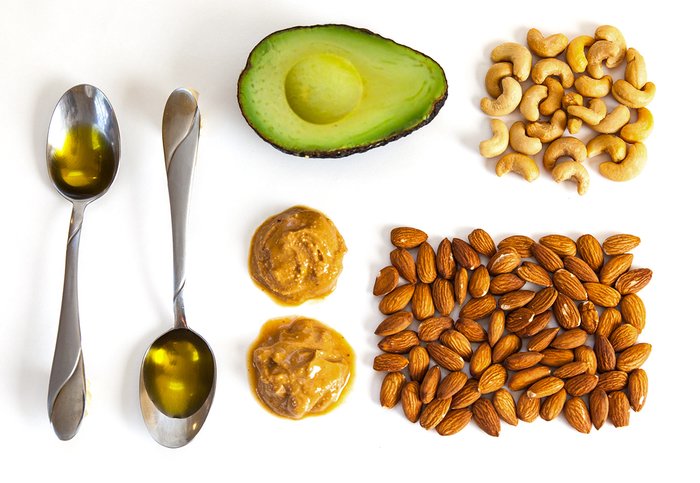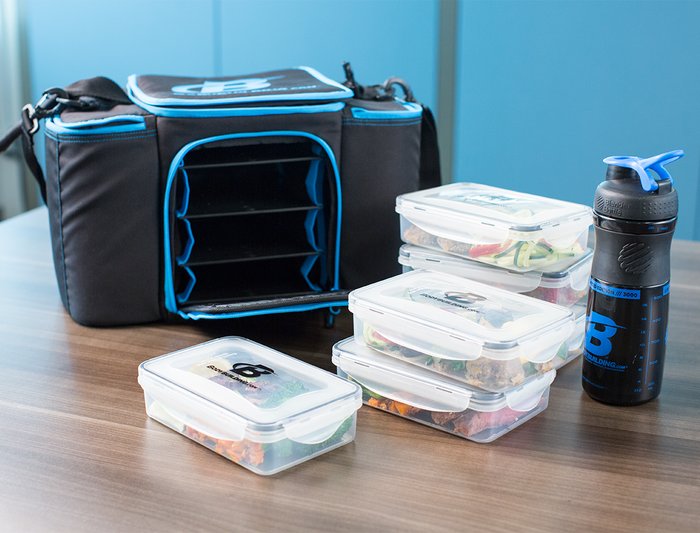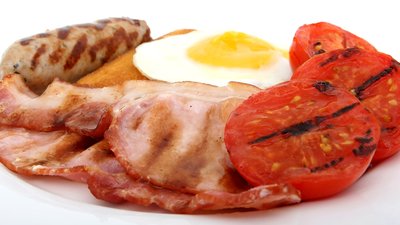More and more athletes are experimenting with ketogenic diets for a variety of reasons. A ketogenic diet can sometimes result in drastic improvements in metabolic health and help athletes lose body fat without sacrificing muscle mass.[1-3] This change in body composition translates to a higher power-to-weight ratio.[4]
Additionally, emerging research suggests ketogenic diets may be beneficial for reducing oxidative stress and improving mental acuity. The latter would not only help keep you focused during your workouts but also potentially speed up the recovery process.[4-7]
But dieters, beware: The feelings of greater energy and enhanced mental acuity don't happen overnight. In fact, it can take several weeks for the body to fully adapt to a ketogenic diet.[8] Many people who try to go keto never make it to this point, due to unpleasant side effects such as headaches, constipation, and a sluggish feeling that can occur when careful planning doesn't take place.[9]
Mistake 1. Fearing Fat
Much of the conventional nutrition wisdom advocates fat avoidance. However, on a ketogenic diet, fat needs to be your friend! The majority of your calories (more than 65 percent) will be coming from dietary fat. This can seem intimidating, but without enough fat, you might not consume enough calories. Alternatively, you might consume too much carbohydrate or protein for your keto lifestyle.[9]

The Fix: First, you need to know which foods contain a lot of fat. Armed with that information, planning ahead and prepping meals can help keep you keep your fat intake on track and ensure it is within your goal ranges.
One way to ensure you don't exceed your daily limit for carbs or protein while on a ketogenic diet is to periodically check your ketone levels. Nutritional ketosis can be checked at home either using urine sticks (if within the first few weeks of the diet) or a finger prick (beyond the first few weeks of adaptation). Nutritional ketosis is defined as ketone levels of 0.5-3.0 mmol/L.[4]
Mistake 2. Consuming Too Much Protein
A ketogenic diet is a moderate-protein diet, not a high-protein diet.[9] While this may be a tough pill to swallow for athletes used to eating over 2 grams of protein per pound of body weight, that much daily protein will make it nearly impossible for your body to become keto-adapted.
The Fix: To find out how much protein you need to eat during your ketogenic diet, start off by calculating the total calories you need for your goal. Although individualized, protein intake on a ketogenic diet typically ranges from 15-25 percent. Once you know your total calories, multiply that number by 0.15-0.25. To figure out how many grams of protein to shoot for each day, divide that number by 4.
Great sources of protein while on a ketogenic diet include fattier cuts of meat, such as beef or pork; fish or other seafood; whole eggs; and cheese.
Mistake 3. Consuming Too Little Sodium
For any athlete, maintaining proper sodium balance is essential for optimal performance. This is especially true for those switching to a ketogenic diet. Although you may notice some initial weight loss during the first few days following a ketogenic diet, much of this is due to a loss of water and sodium as result of reduced carb intake.
Loss of sodium disrupts the body's natural electrolyte balance and can affect several other mineral levels for an athlete.[10] Unless properly replenished, this imbalance of water and sodium can lead to symptoms commonly referred to as the "keto flu," which include headaches, poor concentration, faintness, and nausea. Sodium loss via the diet, in addition to sodium loss during exercise, can hurt your workouts.

The Fix: Supplement with extra sodium starting on day one of your keto diet! Many of the aforementioned symptoms can be drastically reduced, or even completely avoided, by properly supplementing with sodium and water.
Aim to include an additional 1-2 grams of salt into your daily diet.[9] An easy way to achieve this each day is by liberally salting your foods and drinking broth made from one or two bouillon cubes.
Mistake 4. Avoiding Saturated Fat
Levels of saturated fat in your diet do not always directly link to higher levels of cholesterol in your blood. Consuming a diet high in saturated fat and high in carbohydrates can lead to major health implications, but once dietary carbohydrates are reduced, saturated fat becomes a preferred source of energy for the body.[11,12]
In fact, even though many ketogenic diets contain higher-than-recommended levels of saturated fat, researchers have found circulating levels of cholesterol in the body actually decrease—so long as carbohydrates are reduced![13]
The Fix: Your main sources of fat on a ketogenic diet should be monounsaturated and saturated fats. Olive oil, macadamia nuts, and avocados all make for great sources of monounsaturated fats, whereas your saturated fats can come from meats, high-fat dairy (cheese, butter, heavy cream), and coconut oil.
Mistake 5. Failing to Plan Meals
Ketogenic dieting can lead to a variety of health and wellness benefits, but it does require proper planning and adjustments in order to be successful.[14] As with any change in nutrition, life obstacles can cause last-minute meal decisions that may knock you off the wagon. Traveling, holiday parties, and family functions are all potential pitfalls.

The Fix: Take the time to plan ahead and create backup strategies to avoid falling prey to easy-to-grab carb sources. Planning out your weekly meals and picking a day (like Sunday) to meal prep can help ease last-minute meal decisions. Carry low-carb snacks, like Quest bars, protein powder, string cheese, packets of mixed salted nuts, or pork rinds. for times you have to eat on the go.
If you're heading to a social event, bring a crowd pleaser that is also keto-friendly. Here are a few examples:
- Deviled eggs
- Cream-cheese-filled celery
- Buffalo chicken dip
- Cheese-stuffed olives
- Bacon wrapped shrimp
Switching to a ketogenic diet is a lifestyle change that can expose you to some tasty, creative meals and can lead to improvements in health and wellness. However, it can also be challenging and overwhelming to change your diet so drastically.
Keeping these tips in mind can help you stay informed and on track to ensure a positive and successful shift into the low-carb lifestyle.
References
- Tinsley, G. M., & Willoughby, D. S. (2016). Fat-Free Mass Changes During Ketogenic Diets and the Potential Role of Resistance Training. International Journal of Sport Nutrition & Exercise Metabolism, 26(1).
- Paoli, A., Bianco, A., Damiani, E., & Bosco, G. (2014). Ketogenic diet in neuromuscular and neurodegenerative diseases. BioMed Research International, 2014.
- Jabekk, P. T., Moe, I. A., Meen, H. D., Tomten, S. E., & Høstmark, A. T. (2010). Resistance training in overweight women on a ketogenic diet conserved lean body mass while reducing body fat. Nutrition & Metabolism,7(1), 1.
- Volek, J. S., Noakes, T., & Phinney, S. D. (2015). Rethinking fat as a fuel for endurance exercise. European Journal of Sport Science, 15(1), 13-20.
- Shimazu, T., Hirschey, M. D., Newman, J., He, W., Shirakawa, K., Le Moan, N., ... & Newgard, C. B. (2013). Suppression of oxidative stress by beta-hydroxybutyrate, an endogenous histone deacetylase inhibitor. Science, 339(6116), 211-214.
- Rhyu, H. S., Cho, S. Y., & Roh, H. T. (2014). The effects of ketogenic diet on oxidative stress and antioxidative capacity markers of Taekwondo athletes. Journal of Exercise Rehabilitation, 10(6), 362.
- Milder, J., & Patel, M. (2012). Modulation of oxidative stress and mitochondrial function by the ketogenic diet. Epilepsy Research, 100(3), 295-303.
- Volek, J. S., Freidenreich, D. J., Saenz, C., Kunces, L. J., Creighton, B. C., Bartley, J. M., ... & Lee, E. C. (2016). Metabolic characteristics of keto-adapted ultra-endurance runners. Metabolism, 65(3), 100-110.
- Phinney, S. D. (2004). Ketogenic diets and physical performance. Nutrition & Metabolism, 1(1), 1.
- Phinney, S. D., Bistrian, B. R., Evans, W. J., Gervino, E., & Blackburn, G. L. (1983). The human metabolic response to chronic ketosis without caloric restriction: preservation of submaximal exercise capability with reduced carbohydrate oxidation. Metabolism, 32(8), 769-776.
- Volek, J. S., Phinney, S. D., Forsythe, C. E., Quann, E. E., Wood, R. J., Puglisi, M. J., ... & Feinman, R. D. (2009). Carbohydrate restriction has a more favorable impact on the metabolic syndrome than a low fat diet. Lipids, 44(4), 297-309.
- Volek, J. S., & Forsythe, C. E. (2005). The case for not restricting saturated fat on a low carbohydrate diet. Nutrition & Metabolism, 2(1), 1.
- Forsythe, C. E., Phinney, S. D., Feinman, R. D., Volk, B. M., Freidenreich, D., Quann, E., ... & Bibus, D. M. (2010). Limited effect of dietary saturated fat on plasma saturated fat in the context of a low carbohydrate diet. Lipids, 45(10), 947-962.
- Westman, E. C., Mavropoulos, J., Yancy Jr, W. S., & Volek, J. S. (2003). A review of low-carbohydrate ketogenic diets. Current Atherosclerosis Reports, 5(6), 476-483.

